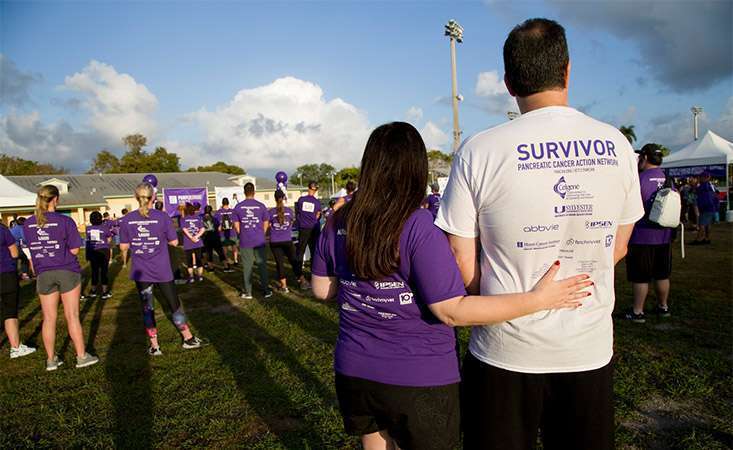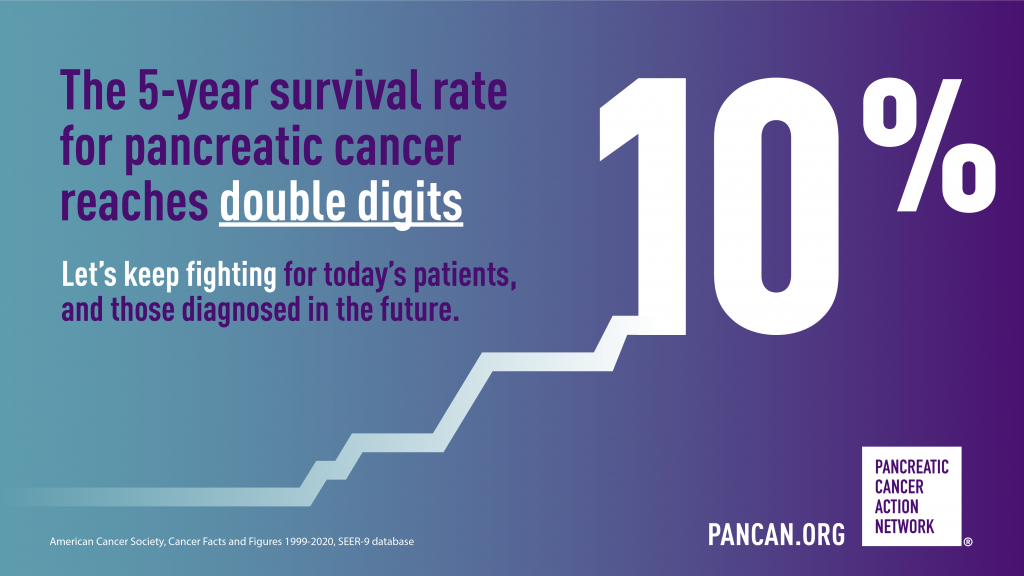
For the first time ever, the five-year survival rate for pancreatic cancer has reached double digits.
American Cancer Society’s Cancer Facts & Figures, released today, reports that the five-year survival rate has increased to 10%*.
“I am extremely proud that PanCAN was willing to take the lead and put a stake in the ground to set an ambitious goal to double pancreatic cancer survival by 2020. To reach double digits is a tremendous milestone and sets the stage for what’s to come in our efforts against the world’s toughest cancer,” said Julie Fleshman, JD, MBA, president and CEO of the Pancreatic Cancer Action Network (PanCAN).
PanCAN set the goal in 2011 to double pancreatic cancer survival by 2020. At the time, the five-year survival rate was just 6%.
“The entire community of pancreatic cancer researchers, healthcare professionals, volunteers and advocates rallied around our 2020 goal and worked together to accelerate progress against the world’s toughest cancer, and we are so grateful for their dedication and diligent efforts,” Fleshman said.
Improvement in the survival rate is critical, because the Facts & Figures report also reveals that more people will be diagnosed with pancreatic cancer than ever before.
In 2020, an estimated 57,600 Americans will be diagnosed with pancreatic cancer. Approximately 47,050 Americans are expected to die from the disease this year.
Pancreatic cancer is the 11th most commonly diagnosed cancer in the U.S., but it’s the third leading cause of cancer-related deaths.
“These new statistics underscore the urgency of continuing to focus research, funding and attention on this disease and its threat to society,” Fleshman said.
Since its founding in 1999, PanCAN has taken a comprehensive approach to attack pancreatic cancer on all fronts: research, clinical initiatives, patient services and advocacy.
“Seeing the pancreatic cancer survival rate rise to 10% is evidence our strategies are working,” Fleshman said. “Since declaring our goal to double survival, we’ve taken critical steps to advance research and introduce innovative programs and services to directly support patients.”

A key example is PanCAN’s Know Your Tumor® precision medicine service, launched in 2014 to determine whether patients’ tumor biology can impact their treatment decisions and outcomes.
Fleshman recalled, “We were met with skepticism from the scientific and medical communities that testing of pancreatic cancer patients’ tumors wouldn’t provide clinically useful information.”
Today, one out of every four patients who receive personalized Know Your Tumor reports find out about “actionable” findings – results that can influence that patient’s treatment options.
Further evidence has shown that patients with actionable findings who go on therapy that matches their biological characteristics have better outcomes.
In fact, Lynparza® (olaparib), a targeted therapy, just received FDA approval in late December to treat subsets of pancreatic cancer patients who were born with BRCA mutations. Patients won’t know if they qualify for Lynparza or certain other therapies without undergoing the appropriate testing.
“Today, these tests are standard practice and recommended in major clinical guidelines – thanks in part to PanCAN’s published positive results and our willingness to take a risk by launching this leading-edge initiative,” Fleshman said.
In addition, since PanCAN declared its goal to double pancreatic cancer survival, there are now nine new treatment options that can benefit patients with pancreatic cancer.
These treatment advances were made possible by patients participating in clinical trials. PanCAN strongly recommends clinical trials at diagnosis and during every treatment decision – throughout January, National Pancreatic Cancer Clinical Trials Awareness Month – and year-round.
Patients, caregivers and healthcare professionals can receive personalized clinical trials information through PanCAN Patient Services, which maintains the most comprehensive and up-to-date database of pancreatic cancer clinical trials available in the United States.
It’s important to note that in order to calculate the five-year survival rate, NCI’s SEER team followed patients through 2016. So, more recent advancements and the impact of newly approved treatment options are not reflected in this year’s calculations.
“We’ve come so far with our goal to double survival by 2020,” Fleshman said. “This sets the stage for what’s to come in the next decade as we accelerate progress with new initiatives, including PanCAN’s Precision PromiseSM adaptive clinical trial and other efforts to improve treatment options and move toward effective early detection strategies.”
She continued, “Without the generosity of compassionate donors, none of these advancements would have been possible. With continued donations, imagine what the next decade holds for pancreatic cancer patients.”
*Rates are adjusted for normal life expectancy and are based on cases diagnosed in the SEER 9 areas from 2009 to 2015, followed through 2016 (table 7).
















